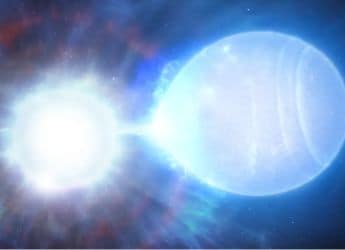- Home
- Science
- Science News
- NASA Spacecraft to Collide a Small Moonlet in 2022
NASA Spacecraft to Collide a Small Moonlet in 2022
The spacecraft called Double Asteroid Redirection Test (DART) will carry an optical navigation system to capture images that help the spacecraft reach its target.

Photo Credit: Johns Hopkins Applied Physics Laboratory
The US space agency NASA revealed on Monday details about its plan to hit a small moonlet target in a double asteroid system with a spacecraft in 2022, its first mission to demonstrate a planetary defence technique.
The asteroid, called Didymoon or Didymos B, is a moon asteroid around 150 meters tall orbiting a larger body Didymos A, the most accessible asteroid of its size from the Earth, the Xinhua news agency reported.
An international campaign is now making observations using powerful telescopes worldwide to understand the state of the asteroid system.
"The Didymos system is too small and too far to be seen as anything more than a point of light, but we can get the data we need by measuring the brightness of that point of light, which changes as Didymos A rotates and Didymos B orbits," said Andy Rivkin, a co-lead of the investigation team.
Researchers are still not sure about the target's composition: whether it is composed of solid rock, loose rubble or "softer" sand. A softer surface would absorb much of the impact force and may not be pushed as drastically as if a spacecraft hit a harder surface.
But the NASA team will eventually see the asteroid system close-up thanks to an Italian-made imager. The shoebox-sized cube satellite will record the spacecraft's impact and its aftermath.
The spacecraft called Double Asteroid Redirection Test (DART) will carry an optical navigation system to capture images that help the spacecraft reach its target.
In its latest design, DART spacecraft will be able to move by relying on small hydrazine thrusters while utilising the electric propulsion system, which will push the start of the primary launch window to July of 2021, shortening the mission flight time. Its previous planned launch time was December 2020.
The DART spacecraft will crash itself into the asteroid at a speed of approximately six kilometer per second and the collision will change the speed of the moonlet in its orbit around the main body by a fraction of one per cent, enough to be measured using telescopes on the Earth, according to the NASA.
For the latest tech news and reviews, follow Gadgets 360 on X, Facebook, WhatsApp, Threads and Google News. For the latest videos on gadgets and tech, subscribe to our YouTube channel. If you want to know everything about top influencers, follow our in-house Who'sThat360 on Instagram and YouTube.
- Samsung Galaxy Unpacked 2025
- ChatGPT
- Redmi Note 14 Pro+
- iPhone 16
- Apple Vision Pro
- Oneplus 12
- OnePlus Nord CE 3 Lite 5G
- iPhone 13
- Xiaomi 14 Pro
- Oppo Find N3
- Tecno Spark Go (2023)
- Realme V30
- Best Phones Under 25000
- Samsung Galaxy S24 Series
- Cryptocurrency
- iQoo 12
- Samsung Galaxy S24 Ultra
- Giottus
- Samsung Galaxy Z Flip 5
- Apple 'Scary Fast'
- Housefull 5
- GoPro Hero 12 Black Review
- Invincible Season 2
- JioGlass
- HD Ready TV
- Laptop Under 50000
- Smartwatch Under 10000
- Latest Mobile Phones
- Compare Phones
- OnePlus 13T
- Honor 400 Lite
- Honor Play 60m
- Honor Play 60
- Poco C71
- Lava Bold 5G
- Huawei Pura X
- Motorola Edge 60 Fusion
- Asus Vivobook 16 (AMD, 2025)
- Asus Zenbook S16 (AMD, 2025)
- Samsung Galaxy Tab S10 FE+
- Samsung Galaxy Tab S10 FE
- Huawei Watch Fit 3
- Garmin Instinct 3
- Haier M80F Mini LED 4K
- Haier M95E
- Nintendo Switch 2
- Sony PlayStation 5 Pro
- Whirlpool 1.5 Ton 3 Star Inverter Split AC (SAI18K38DC0)
- Whirlpool 1.5 Ton 5 Star Inverter Split AC (SAI17B54SED0)












